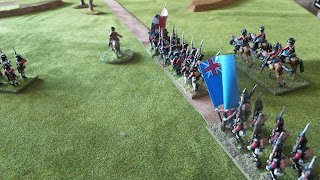The premise is one that echoes real world issues, and something which we've looked at with various rulesets previously: that of Private Military Contractors in hotspots around the world - albeit a little further into a rapidly decaying, quasi fictional, future.
We've used 20mm minis with printouts of some of the playtest materials, but fully laminated cards, gaming boards and cool minis are likely to be available in the final game.
The turn sequence is designed to have a boardgame feel - so we see the PMC turn followed by the local forces, and there is a great escalation mechanic which puts more and more stress upon the PMC team to get to the target building, and find the High Value Target (HVT) with each passing turn.
Highlights included:
- That escalation mechanic drives the game. There is a real sense of time running out, as more and more escalation levels drive heightened violence. Despite our best attempts to control the situation and 'stealth in' without being seen; damned roving NPCs kept spotting us. Each time the PMCs are spotted, or fail to take out an insurgent in one round - the level goes up, until 'suspicious' (NPCs can see further) then 'compromised' (heightened activity from enemy) escalation situations occur.
- There are nice resource management issues related to whether you can afford to split your team up and cover more ground, and/or lose the ability to pour fire on moving targets because of said force division.
- The buildings each feature a random location card - you can get Intel or 'contact' trouble and spawning points.
- Separate turn driven Intel cards can throw in random benefits or problems during a game - just to add to the pressure :)
- Combat and movement is relatively straightforward, but the escalation and 'swarming' of the enemy around you is the real meat of the game.
- Once you determine the HVT's target building - a different board is used - stack up, flashbang in, and go for some CQB.
Initial setup with random elements (hidden) in buildings.
Alpha enter the urban area. There is great scope here for linked scenarios in a campaign, as the surrounding country degenerates into civil war for instance (I'm thinking '13 Hours' as example). Also great basis for wider rural scenarios, close protection, convoy protection - even sabotage, observation etc.
Local units start to become revealed - initially, the team remains undiscoverd, but these guys will start to move to engage when the escalation level gets high enough...saving the trouble for later here.
Alpha uses 2 by 2 and fire and movement to ambush two fighters in the street.
Some buildings can prove useful for Intel - though make the wrong roll and they turn into a Hornet's Nest of angry locals with AKs.
And then it all kicked off - too many instances of being seen and not enough of staying out of the way. The team was compromised on the same turn it found the target building with the HVT.
Time to get in. The breach is a 'hard knock' since the whole area knows what is going on now, and there are only two turns to hit the target before the place blows.
Some good rolls and movement forcing the target's bodyguards to react - the flashbang lost them a critical turn as the mission is completed...
...sort of, a compromised team gets followed by a lot of angry locals...and they don't want to talk, but that's the second turn of insertion. Will they get out in time?
A really nice game, and the escalation mechanic and feeling of stealthing through quiet streets is actually quite palpable. Cards, figures and art will all heighten the feel of the game by the time it comes out. Great stuff here.




























































